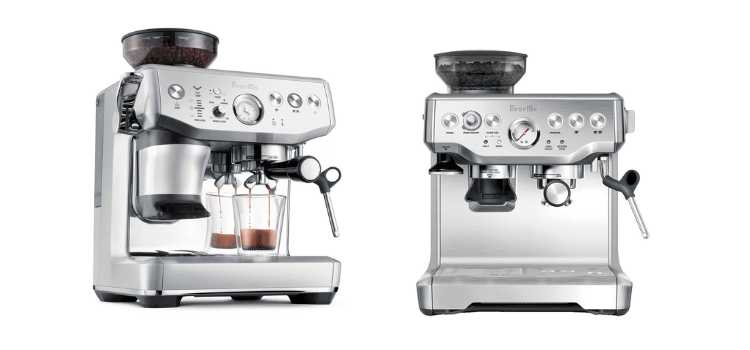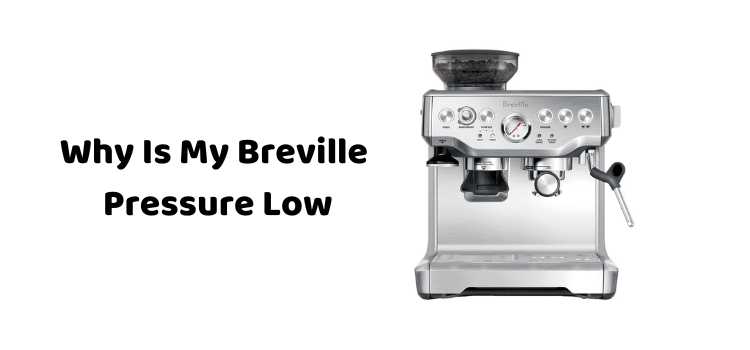As an Amazon Associate, I earn from qualifying purchases

Picture this: It’s a crisp morning, and you’re craving that perfect shot of espresso. You eagerly approach your Breville machine, ready to enjoy your favorite brew. But alas, the pressure gauge isn’t quite hitting the mark.
Low pressure can turn a promising coffee ritual into a frustrating endeavor, leaving you with a lackluster shot that lacks the richness and crema you expect. Understanding why your Breville espresso machine might be experiencing low pressure is key to resolving the issue and restoring the quality of your espresso.
Common Causes of Low Pressure
Let’s delve into the common culprits behind low pressure in your Breville machine. Understanding these factors can help you pinpoint the issue and take corrective measures.
- Blockages in the Machine’s Components: Over time, coffee oils and residue can build up in the group head, portafilter, and other components. These blockages can restrict water flow, leading to reduced pressure. Regular cleaning is essential to prevent this buildup.
- Inconsistent or Insufficient Grind Size: The grind size of your coffee beans is crucial for proper extraction. If the grind is too coarse, water will flow through too easily, resulting in low pressure. Conversely, overly fine grinds can cause blockages. Striking the right balance is key.
- Problems with the Pump or Pressure Gauge: The pump is responsible for generating the necessary pressure for brewing. If the pump isn’t functioning correctly or if the pressure gauge is faulty, it can result in low pressure. Regular maintenance checks can help identify these issues.
- Water Reservoir Issues or Airlocks: Sometimes, the issue might be as simple as an improperly seated water reservoir or an airlock in the system. These can disrupt the water flow and pressure, leading to inconsistent brewing.
Troubleshooting Steps

Once you’ve identified potential causes, it’s time to troubleshoot and resolve the issue. Here’s a step-by-step guide:
- Check and Clean Components: Begin by disassembling the group head and portafilter. Clean them thoroughly to remove any coffee residue or oils that might be causing blockages. Use a brush and appropriate cleaning solution for best results.
- Adjust Grind Size: Experiment with your grinder to find the optimal setting. Aim for a consistent grind that allows for proper extraction. If you’re unsure, start with a medium-fine grind and adjust based on the pressure readings.
- Assess the Pump: Listen for any unusual sounds from the pump. If it seems weak or inconsistent, it might need servicing. Check your machine’s manual for guidance on accessing and inspecting the pump.
- Ensure Proper Water Flow: Make sure the water reservoir is correctly seated. Remove any air bubbles by running a small amount of water through the system without coffee, allowing the pump to prime effectively.
Maintenance Tips to Prevent Pressure Issues
Regular maintenance is your best defense against low pressure and other common espresso machine woes. Here are some tips to keep your Breville in top shape:
- Regular Cleaning and Descaling: Establish a routine to clean your machine daily, especially the group head and portafilter. Descale the machine periodically to prevent mineral buildup that can affect performance.
- Use the Correct Coffee Grind: Invest in a quality grinder and take time to calibrate it according to the coffee beans you use. Different beans may require slight adjustments to achieve the right pressure and extraction.
- Routine Component Checks: Regularly inspect seals, gaskets, and other components for wear and tear. Replace any parts that appear damaged or worn out to maintain optimal pressure and performance.
- Proper Storage and Handling: When not in use, ensure your machine is stored in a dry, cool place. Avoid exposing it to excessive moisture or heat, which can damage internal components.
Conclusion
Brewing the perfect espresso is an art that requires attention to detail, particularly when it comes to maintaining the right pressure. Understanding the causes of low pressure in your Breville machine and taking proactive steps to troubleshoot and prevent these issues can make all the difference in your espresso experience.
By regularly cleaning and maintaining your machine, using the correct grind size, and addressing any mechanical issues promptly, you can ensure that your Breville espresso machine continues to deliver rich, flavorful shots that rival those of your favorite café. So, embrace the journey of mastering your espresso craft, and enjoy the rewards of a well-brewed cup every morning.
FAQ
Why is my pressure too low on Breville?
Low pressure on a Breville machine can be due to blockages in the group head or portafilter, an incorrect grind size, or pump issues. Regular cleaning, ensuring the right coffee grind, and checking the pump functionality can help resolve pressure problems.
Why is my espresso machine not getting enough pressure?
Insufficient pressure in an espresso machine may result from clogged components, an improperly seated water reservoir, or airlocks. Check for obstructions, adjust the grind size, and ensure the water flow is unobstructed to improve pressure.
How to get more pressure on Breville Barista Express?
To increase pressure on the Breville Barista Express, clean the group head and portafilter, adjust the grind to a finer setting, and ensure the water reservoir is properly positioned. Regular maintenance and descaling can also help maintain optimal pressure levels.
Why is my Breville not pouring enough water?
If your Breville isn’t pouring enough water, check for blockages in the water line, ensure the reservoir is full and correctly placed, and inspect for airlocks. Cleaning the machine and running a water-only cycle can help clear any obstructions.
As an Amazon Associate, I earn from qualifying purchases